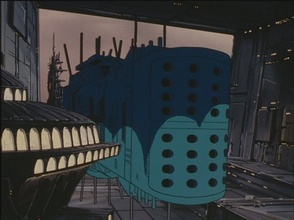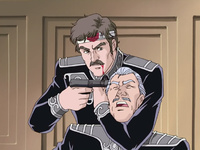Seventh Battle of Iserlohn
From Gineipaedia, the Legend of Galactic Heroes wiki
| Seventh Battle of Iserlohn | |||||
| (First Alliance–Imperial War) | |||||
 The Hyperion docking in Iserlohn Fortress | |||||
| Date: | 14–15 May 796 UC (487 IC / 3596 CE) | ||||
| Location: | Iserlohn Fortress | ||||
| Result: | Major Alliance victory | ||||
| |||||
| |||||
| |||||
| |||||
| |||||
The Seventh Battle of Iserlohn (Japanese: 第7次イゼルローン攻防戦) was the seventh and final military offensive launched by the Free Planets Alliance against the Galactic Empire's front-line stronghold, Iserlohn Fortress. It led to the capture of Iserlohn by the Alliance in May 796 UC (487 IC / 3596 CE), which was carried out by Admiral Yang Wen-li with only half of a normal Alliance fleet, using a plan that relied on subterfuge rather than brute force. This was preceded by six previous failed attempts that brought nothing but millions of Alliance casualties, and Yang's achievement in capturing the impregnable Fortress using minimal resources while taking no losses further solidified his status as a hero and military genius in the Alliance.
The fall of Iserlohn Fortress changed the strategic balance of power in the Alliance–Imperial War immensely, giving the Alliance the advantage and now putting the Empire on the defensive. It made possible the invasion of the Empire by Alliance forces later that year, and after that ending in failure and the subsequent Alliance Civil War led to the destruction of most of the Free Planets Star Fleet, Iserlohn would serve as the Alliance's last line of defense until Operation Ragnarök in 799 UC (1 NIC / 490 IC / 3599 CE).
Contents |
Background
During the Battle of Astarte in January 796 UC (487 IC / 3596 CE), Commodore Yang Wen-li made a name for himself by saving the Alliance 2nd Fleet from the verge of total destruction and bringing the Alliance the only success it had during that disastrous engagement. Upon his return to Heinessen however, he offended Secretary of Defence Job Trunicht by defending his friend Jessica Edwards from the brutality of the Patriotic Knights Corps, who had targeted her after she publicly criticised Trunicht in a memorial service honouring the casualties from the Battle of Astarte. Fleet Admiral Sidney Sithole, as one of the few senior military officers opposed to the growing power of the Secretary of Defence, was finding his position increasingly tenuous in the aftermath of the major Alliance defeat at Astarte. It was under such circumstances that appointed Yang Wen-li as the commander of the 13th Fleet and tasked him with the seemingly impossible task of capturing Iserlohn Fortress, hoping that success would serve to strengthen his own position and check Trunicht's growing power. (LOGH: 'Birth of the 13th Fleet')
Due to Yang's reputation as a brilliant military commander, the task was also given to him as it was believed that he was the only one who had a chance of succeeding. To do it he was appointed commander of the newly formed 13th Fleet, which was an amalgamation of survivors from the 2nd, 4th, and 6th Fleets that took part in the Astarte fiasco and new recruits, making it only half the size of a standard Alliance fleet. Since the six previous attempts (the most recent one of which Yang had taken part in earlier in his career) all used bigger numbers than he did and still failed, Yang planned to use subterfuge to take the Fortress rather than force. He had the logistics officer Alex Cazerne procure him a captured Imperial warship, several hundred Imperial uniforms, and the Rosen Ritter elite infantry regiment that consisted of of Imperial emigres to assist him with this task. (LOGH: 'Birth of the 13th Fleet')
Opposing forces
Alliance order of battle
The Alliance deployed only its recently formed 13th Fleet, a new formation that was only half the size of normal Alliance fleet. Its ground forces notably included the Rosen Ritter special operations infantry regiment. The total fleet numbered 6400 warships and 700,000 personnel.
- The 13th Fleet, commanded by Rear Admiral Yang Wen-li, flagship Hyperion
Imperial order of battle
Iserlohn Fortress was defended by a space fleet and a garrison of troops, each commanded by a different officer. The stationed fleet included approximately 15,000 warships, and the garrison numbered 500,000 troops. (LOGH: 'Invasion of the Imperial Territory')
- The Iserlohn Stationed Fleet, commanded by Admiral Hans Dietrich von Seeckt, flagship unknown
- The Fortress Garrison, commanded by Admiral Thoma von Stockhausen
Battle
On 14 May 796 UC (487 IC / 3596 CE), the Alliance's Rosen Ritter commandos flew the damaged captured Imperial cruiser Bremen to the fortress, pretending to be wounded Imperial forces that were being pursued by Alliance warships after having acquired important intelligence. Before then Rear Admiral Yang Wen-li drew the Iserlohn fleet away from the fortress with decoys, causing the Imperial fleet commander Hans Dietrich von Seeckt to spend several hours searching for what was really a decoy, and advanced towards Iserlohn whilst the Imperial fleet was too far away to maintain contact. Admiral Seeckt, and the fortress commander Thoma von Stockhausen, had had an intense rivalry and often bickered with each other. Although Stockhausen and a fleet staff officer, Captain Paul von Oberstein, had voiced caution about responding to what would ultimately prove to be decoys but due to their rivalry, this only made Seeckt more intent to do the exact opposite.

The 13th Fleet then began manoeuvring back and forth just outside the range of Iserlohn's main cannon, the Thor Hammer. By this time, the Rosen Ritter soldiers led by Captain Walter von Schönkopf had docked and demanded to see the fortress's commander immediately, claiming to have access to vital intelligence concerning an Alliance invasion of the Iserlohn Corridor. Iserlohn's commander, Admiral Thoma von Stockhausen, was confused by the odd movements of Yang's fleet. The Rosen Ritter infiltrators, brought to the fortress command room, indicated that the strange movements were part of the Alliance's plan to seize the fortress. The disguised Alliance commandos were then allowed close to Stockhausen, enabling Schönkopf to tackle the admiral and hold him hostage. Within seconds, the Rosen Ritter infiltrators seized complete control over Iserlohn's command centre. Stockhausen surrendered and ordered the other personnel in the command centre to stand down, at which point the Rosen Ritter were able to lock down the fortress and disable all of its weapon systems.
The Rosen Ritter then had a short time window to fight their way against Imperial troops to the navigation center to open the Fortress so that Yang would be able to bring the 13th Fleet inside Iserlohn unmolested, before the larger Imperial fleet could return to Iserlohn upon learning that they had followed decoys. At the same time Yang then sent a message to the Imperial fleet commander, Admiral Seeckt, informing him that he had occupied Iserlohh Fortress, and asking for Seeckt to surrender. Of course, although Yang's fleet had access to the fortress, and the Rosen Ritter were in control of the command centre, the Imperial forces stationed aboard were still resisting. Seeckt's staff officer, Paul von Oberstein, advised Seeckt to attack the Alliance warships while the Iserlohn garrison was still fighting, correctly determining that Iserlohn was not yet under Yang's control which was why the 13th Fleet did not dock yet. Seeckt, however, ignored Oberstein's advice, and kept his fleet a safe distance away from the fortress to observe the situation outside of the Thor Hammer's range.

This gave Yang and the Rosen Ritter ample time to complete their take-over of Iserlohn. By the time Seeckt realised he had been tricked, Iserlohn had fallen to Yang already, and the 13th Fleet quickly docked inside the Fortress. Seeckt belatedly ordered the Imperial fleet to attack, again going against Oberstein's advice, who realised that the battle was lost, and Yang used the massive destructive power of the Thor Hammer to rout the Imperial forces, destroying more than 1,000 Imperial ships with a single shot. Yang again sent a message to Admiral Seeckt, requesting that he either surrender or withdraw from battle. Captain Oberstein meanwhile had left the Imperial flagship on a shuttle by his own accord.
Admiral Seeckt responded, saying, 'You do not understand a soldier's heart: our code will not allow us to endure living with dishonour. Dying to fulfil our honour, that is our code. For the glory of the Kaiser, all ships will charge to die in an honourable defeat.' Seeckt then ordered the Imperial fleet to advance; in an effort to prevent excessive casualties, Yang targeted Seeckt's flagship with the Thor Hammer and destroyed it (along with several nearby Imperial ships). With Seeckt dead, the Imperial fleet withdrew, thus ending the Seventh Battle of Iserlohn in a major victory for the Free Planets Alliance.
Six times before, the Alliance had attempted to take Iserlohn from the Empire, and six times before they had failed. Yang managed to take the fortress with the smallest fleet out of the seven total attacks, and did so without a single casualty. For this, he became the greatest hero in the Free Planets Alliance, earning the nicknames 'Miracle Yang' and 'Yang the Magician'. (LOGH: 'Iserlohn Captured!')
Aftermath
Iserlohn Fortress had been a major supply base and staging area for Imperial invasions of the Alliance. Its capture had secured the Alliance's borders against easy Imperial attacks and Yang had hoped this might enable the Alliance to negotiate a favourable peace treaty with the Empire. However the Alliance High Council, for private political gain, and the Alliance public, giddy with the taste of victory, instead opted to invade the Empire ostensibly to liberate its people and overthrow autocracy. The Council took this decision to maintain their own support ahead of an election, while the plan itself had been proposed by an ambitious general staff officer named Andrew Falk, who sought to use it for his own advancement. Despite his own strengthened position and reservations about the proposed invasion, Fleet Admiral Sithole was unable to prevent this decision. (LOGH: 'Invasion of the Imperial Territory')
The fall of the fortress shocked the Empire. The Imperial High Command would begin daily strategic meetings discussing the situation in response to the fall of Iserlohn. As the only survivor of Seeckt's flagship and command staff, Captain Paul von Oberstein was targeted for court-martial and punishment. The three Imperial joint chiefs of staff (Steinhof, Ehrenberg, and Mückenberger) also felt compelled to resign in order to assume responsibility for the loss. Reinhard von Lohengramm interceded on their behalf and persuaded Friedrich IV to reject their resignations. In exchange, they dropped any plans for punishing Oberstein, who then joined Reinhard's staff and would become one of the young admiral's most important allies. (LOGH: 'Cool, Clear Artificial Eyes', 'The Actress Exits')
The Empire would make its first attempt to recapture the fortress in 798 UC (489 IC / 3598 CE), which relied on using another fortress mobilized using warp engines to attack Iserlohn. That plan failed, and it was not later that year and early January 799 UC (1 NIC / 490 IC / 3599 CE) that the second attempt took place and was successful, which was part of the larger Operation Ragnarök. For three years until then Iserlohn would remain the Alliance's main line of defense. (LOGH: 'The Return', 'Admiral Yang's Ark Fleet')